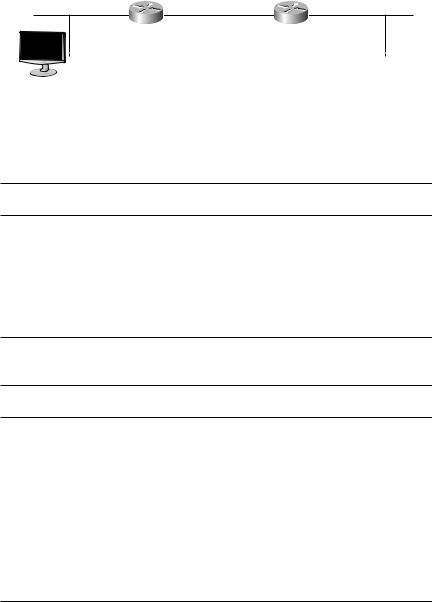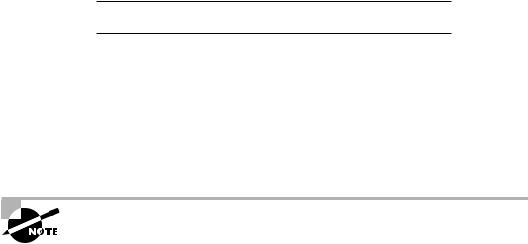
- •Acknowledgments
- •Introduction
- •Assessment Test
- •Answers to Assessment Test
- •Service Provider Networks
- •Scalability
- •Traffic Engineering
- •Quality of Service
- •MPLS Label Stack
- •Shim Header
- •MPLS Architecture
- •Control
- •Forwarding
- •MPLS Label Switching
- •MPLS Network Components
- •Device Output
- •Label-Switched Paths
- •MPLS Applications
- •MPLS and ATM
- •Overlay
- •Quality of Service
- •Traffic Engineering
- •Summary
- •Exam Essentials
- •Key Terms
- •Review Questions
- •Answers to Review Questions
- •Routing Review
- •Frame-Mode MPLS Working Example
- •Network Routing Protocol Examples
- •MPLS Step by Step
- •Label Distribution
- •Assigning Labels
- •Troubleshooting and Verification
- •Device Configuration
- •IGP Verification
- •CEF Verification
- •MPLS Verification
- •Label Distribution and Bindings
- •Binding Verification
- •Troubleshooting the Network
- •Hiding Service Provider Devices
- •Summary
- •Exam Essentials
- •Key Terms
- •Review Questions
- •Answers to Review Questions
- •Frame-Mode MPLS and ATM
- •Frame-Mode MPLS and ATM Configuration
- •Cell-Mode MPLS
- •Label Binding with ATM
- •Cell-Mode Label Switching
- •VC Merge
- •Loop Prevention
- •Cell-Mode MPLS Configuration
- •Summary
- •Exam Essentials
- •Key Terms
- •Review Questions
- •Answers to Review Questions
- •VPNs 101
- •Point-to-Point Connections
- •Virtual Private Networks
- •Categories of VPNs
- •VPN Routing
- •Peer-to-Peer VPNs
- •Optimal Routing
- •Peer-to-Peer Security
- •Peer-to-Peer VPN Routing
- •Summary
- •Exam Essentials
- •Key Terms
- •Review Questions
- •Answers to Review Questions
- •Service Provider Configuration
- •MPLS VPNs
- •Virtual Router
- •Virtual Routing and Forwarding Tables
- •MPLS Operational Overview
- •MP-BGP Configuration
- •An MPLS VPN Example
- •Route Distinguisher
- •MP-IBGP Configuration Example
- •Initial Network Configuration
- •MP-IBGP Configuration
- •Verification
- •Summary
- •Exam Essentials
- •Key Terms
- •Review Questions
- •Answers to Review Questions
- •A Review of VPNs
- •Configuring a Simple MPLS VPN
- •Configuring VRF Interfaces
- •Running RIP in an MPLS VPN
- •Configuring RIPv2 with Address-Family ipv4
- •Configuring Redistribution
- •Route Targets
- •Configuring Route Targets
- •A Review of Simple VPN Configuration
- •Configuring MPLS in the Service Provider Network
- •Simple VPN Configuration
- •Configuring the PE-CE Routing Protocol
- •Lab: Configuring an MPLS VPN
- •Configuring POP Routers
- •VPN Configuration
- •Raleigh Running-Config
- •Atlanta Running-Config
- •Peer 1 Running-Config
- •Peer 2 Running-Config
- •Verification with Ping
- •Routing Table Isolation
- •Verifying VRF Routes
- •Summary
- •Exam Essentials
- •Key Terms
- •Review Questions
- •Answers to Review Questions
- •MP-BGP and OSPF
- •A Review of OSPF
- •OSPF Router Types
- •Link State Advertisements
- •OSPF for MPLS VPNs
- •OSPF Super-Backbone
- •Preventing Routing Loops
- •Path Selection
- •MPLS VPN OSPF Lab
- •Summary
- •Exam Essentials
- •Key Terms
- •Review Questions
- •Answers to Review Questions
- •Static Routing
- •Device Configuration
- •VPN Configuration
- •Raleigh Running-Config
- •Atlanta Running-Config
- •Peer Router Configuration
- •Verification with Ping
- •Verifying Static VRF Routes
- •E-BGP and MPLS VPNs
- •Device Configuration
- •E-BGP Operation
- •AS-Override
- •VPN Configuration
- •Raleigh Running-Config
- •Atlanta Running-Config
- •Peer Router Configuration
- •Peer 1 Running-Config
- •Peer 2 Running-Config
- •Verification with Ping
- •Advanced MPLS VPN Topologies
- •Simple VPNs
- •Central Services MPLS VPN Topology
- •Overlay MPLS VPN Topology
- •Summary
- •Exam Essentials
- •Key Terms
- •Review Questions
- •Answers to Review Questions
- •Challenge Lab 1
- •MPLS
- •MP-IBGP
- •Answer to Lab 1.1
- •Answer to Lab 1.2
- •Answer to Lab 1.3
- •Challenge Lab 2
- •Tag Switching
- •MP-IBGP
- •Answer to Lab 2.1
- •Answer to Lab 2.2
- •Answer to Lab 2.3
- •Challenge Lab 3
- •VRF Configuration
- •RIPv2
- •Redistribution
- •Answer to Lab 3.1
- •Answer to Lab 3.2
- •Answer to Lab 3.3
- •Challenge Lab 4
- •VRF Configuration
- •OSPF
- •Redistribution
- •Answer to Lab 4.1
- •Answer to Lab 4.2
- •Answer to Lab 4.3
- •Challenge Lab 5
- •VRF Configuration
- •Static Routes and Redistribution
- •Answer to Lab 5.1
- •Answer to Lab 5.2
- •Challenge Lab 6
- •VRF Configuration
- •E-BGP Configuration
- •Answer to Lab 6.1
- •Answer to Lab 6.2
- •Service Provider Network Configuration with OSPF
- •Router Configuration
- •Routing Tables
- •Tags
- •Service Provider Network Configuration with IS-IS
- •Router Configuration
- •Routing Tables
- •Tag Switching Forwarding Tables
- •Glossary
32 Chapter 1 An Introduction to MPLS
Answers to Review Questions
1.B. The command to display label bindings in an MPLS environment is show mpls forwarding-table.
2.D. The MPLS label stack header is 32 bits in total size, or 4 octets.
3.B, C. The MPLS label stack is often referred to as a shim header because it resides between the Layer 2 header and Layer 3 payload.
4.C. The label portion of the MPLS label stack is 20 bits in length.
5.C. The command to display label bindings in a tag-switching environment is show tag forwarding-table.
6.B. The correct terminology for an MPLS-capable router/switch is that of a label switch router (LSR).
7.A. Network devices under control of the service provider and that only connect to other provider devices are called P devices.
8.B. Labels enter the service provider network as unlabeled IP. The PE, which is an edge-LSR, imposes a label.
9.C. To improve performance, the penultimate (next-to-last) router in the LSP pops the label and forwards it to the next hop router as an unlabeled packet.
10.B. The Experimental (EXP) field of the MPLS label stack is used for QoS. Packets enter the network as unlabeled IP. An edge-LSR applies the label and can set a value in the Experimental field that is used for QoS by other LSRs.
11.C. The major applications for MPLS are QoS, VPNs, and traffic engineering. An argument could be made that MPLS changes how routing protocols are used by service providers, but MPLS does not replace the need for them.
12.A. The ability to stack labels makes traffic engineering possible in MPLS networks. Label stacking also makes MPLS VPNs possible.
13.D. Cisco’s proprietary way of moving tagged packets through a network is called tag switching.
14.C. The proprietary protocol used by Cisco tag switching to exchange tags is Tag Distribution Protocol (TDP).
Copyright ©2002 SYBEX, Inc., Alameda, CA |
www.sybex.com |
Answers to Review Questions 33
15.A. The protocol used by MPLS to exchange labels is Label Distribution Protocol (LDP).
16.D. Cisco Express Forwarding (CEF) creates an optimized, “cached” version of the routing table. CEF is a requirement for MPLS and tag switching.
17.B. A value of 1 in this field indicates the bottom, or last label, of the stack.
18.C. An FEC is a grouping of IP packets that are treated the same way. For unicast-based routing, an IP prefix is the equivalent of an FEC.
19.A. A label-switched path (LSP) is a unidirectional set of label switch routers (LSRs) that a labeled packet must flow through.
20.A. The proper term for an ATM switch that is MPLS-enabled is ATM-LSR.
Copyright ©2002 SYBEX, Inc., Alameda, CA |
www.sybex.com |

Chapter
2
Frame-Mode MPLS
CCIP MPLS EXAM TOPICS COVERED IN THIS CHAPTER:
Identify the IOS commands and their proper syntax used to configure MPLS on frame-mode MPLS interfaces on IOS platforms.
Describe the label distribution process between LSRs.
Describe frame-mode MPLS and cell-mode MPLS.
Identify the IOS commands and their proper syntax used
to configure advanced core MPLS features (TTL propagation, controlled label distribution) on IOS platforms.
Identify the IOS commands and their proper syntax used
to monitor operations and troubleshoot typical MPLS failures on IOS platforms.
Copyright ©2002 SYBEX, Inc., Alameda, CA |
www.sybex.com |

Chapter 1, “An Introduction to MPLS,” introduced you to the basic operation of MPLS. You learned that with MPLS, packets are switched instead of routed. Unlabeled IP packets enter the service provider network at the edge, and a label is applied. Every label switch router (LSR) in the labelswitched path (LSP) uses that label to label-switch the packet.
This chapter will build on what you already know, adding a little more detail. This chapter starts with a review of traditional Layer 3 routing. To really understand MPLS, you need a solid understanding of Layer 3 routing.
After routing, this chapter takes you though frame-mode MPLS step by step in the “Frame-Mode MPLS Working Example” section. This section builds on the concepts introduced in the previous chapter and focuses on the interaction between MPLS and the routing protocols in the network. If you are not comfortable with LSPs, go back and re-read that section of Chapter 1. Labels and how they are bound to routes are described in greater detail in the “Label Distribution” section. Again, if there are any concepts that you are not totally comfortable with, make sure to re-read Chapter 1’s descrip-
tion of labels.
Finally, this chapter will explain troubleshooting and network verification using configurations and output from a simple network.
Routing Review
You might be thinking to yourself, “I don’t need to read this section on routing,” or “I already know all about routing.” Well, you might already know Layer 3 routing, but please read this section carefully anyway. If the ideas discussed here are somewhat new, take the time to really understand everything you’re reading. If your routing skills are rusty, you may have difficulty understanding the interaction of MPLS and routing protocols.
Copyright ©2002 SYBEX, Inc., Alameda, CA |
www.sybex.com |

Routing Review 37
So, let’s do a quick and dirty review of routing. Figure 2.1 illustrates a simple Layer 3 routed network that you’ll use for this review.
F I G U R E |
2 . 1 |
A sample network for Layer 3 routing |
|
|
|
|
|
Ethernet0 |
Ethernet1 |
Ethernet0 |
Ethernet1 |
|
|
Router 1 |
Router 2 |
|
|
|
|
Host A |
|
|
Host B |
|
|
The IP and MAC addresses for each device in Figure 2.1 are listed in |
|||
|
|
Table 2.1 and Table 2.2. |
|
|
|
T A B L E |
2 . 1 |
Host Addresses |
|
|
|
|
|
|
Host A |
|
Host B |
|
|
IP address |
192.168.1.10 |
192.168.3.10 |
|
|
|
Subnet mask |
255.255.255.0 |
255.255.255.0 |
|
|
|
Default gateway |
192.168.1.1 |
|
192.168.3.1 |
|
|
Mac address |
AAAA-AAAA-AAAA |
BBBB-BBBB-BBBB |
|
T A B L E |
2 . 2 |
Router Addresses |
|
|
|
|
|
|
Router 1 |
Router 2 |
|
|
|
IP address (Ethernet0) |
192.168.1.1 |
192.168.2.2 |
|
|
|
Subnet mask (Ethernet0) |
255.255.255.0 |
255.255.255.0 |
|
|
|
MAC address (Ethernet0) |
1111-1111-1111 |
2222-2222-2222 |
|
|
|
IP address (Ethernet1) |
192.168.2.1 |
192.168.3.1 |
|
|
|
Subnet mask (Ethernet1) |
255.255.255.0 |
255.255.255.0 |
|
|
|
MAC address (Ethernet1) |
3333-3333-3333 |
4444-4444-4444 |
|
Copyright ©2002 SYBEX, Inc., Alameda, CA |
www.sybex.com |

38 Chapter 2 Frame-Mode MPLS
To begin this example, let’s say that Host A wants to send some packets to Host B. The first thing that Host A does is determine whether Host B is local (on the same subnet) or remote (on a different subnet). Host A, by comparing its network at 192.168.1.0 to that of Host B at 192.168.3.0, can see that the network portions of the IP addresses do not match, meaning that Host B is remote. Host A, now knowing that Host B is remote, puts a frame on the wire destined for the default gateway. Table 2.3 shows the Layer 2 and Layer 3 information as placed on the wire.
T A B L E 2 . 3 Layer 2 and Layer 3 Information from Host A to Router 1
From Host A to Router 1
Layer 3 source |
192.168.1.10 |
Layer 3 destination |
192.168.3.10 |
Layer 2 source MAC |
AAAA-AAAA-AAAA |
Layer 2 destination MAC |
1111-1111-1111 |
|
|
As you look over this example, pay close attention to the source and destination IP addresses.
Router 1 knows that the frame is destined for it because it sees its own Ethernet0 MAC address in the destination field in the frame. Router 1 picks the frame up off the wire, discards the Layer 2 information, and looks in the destination part of the Layer 3 header. Router 1, knowing that the packet is destined for network 192.168.3.0, does a Layer 3 lookup and checks its routing table to see if it has an entry for 192.168.3.10. It finds a route to network 192.168.3.0/24 with a next hop of 192.168.2.2 via interface Ethernet1. The following output is the routing table as it exists on Router 1:
Router1#show ip route
R 192.168.3.0/24 [120/1] via 192.168.2.2, 00:00:01, Ethernet1 C 192.168.1.0/24 is directly connected, Ethernet0
C 192.168.2.0/24 is directly connected, Ethernet1
Copyright ©2002 SYBEX, Inc., Alameda, CA |
www.sybex.com |

Routing Review 39
Router 1 knows that to get to network 192.168.3.0, it needs to send the packet out of Ethernet1 to 192.168.2.2. Router 1 programmatically moves the packet to the outbound Ethernet1 interface, creates a new frame, and places the new frame on the wire. Table 2.4 lists the Layer 2 and Layer 3 information as it is placed on the wire from Router 1 to Router 2.
T A B L E 2 . 4 Layer 2 and Layer 3 Information from Router 1 to Router 2
From Router 1 to Router 2
Layer 3 source |
192.168.1.10 |
Layer 3 destination |
192.168.3.10 |
Layer 2 source MAC |
2222-2222-2222 |
Layer 2 destination MAC |
3333-3333-3333 |
|
|
Notice in Table 2.4 that only the Layer 2 source and destination MAC addresses have changed. The Layer 3 information is unchanged.
Router 2 knows that the frame is destined for it because it sees its own Ethernet0 MAC address in the destination field in the frame. Router 2 picks the frame up off the wire, discards the Layer 2 information, and looks in the destination part of the Layer 3 header. Router 2, knowing that the packet is destined for 192.168.3.10, does a Layer 3 lookup and checks its routing table to see if it has an entry for 192.168.3.10. It finds a route to network 192.168.3.0/24 with a directly connected interface of Ethernet1. The following output is the routing table as it exists on Router 2:
Router2#show ip route
R 192.168.1.0/24 [120/1] via 192.168.2.1, 00:00:06, Ethernet0 C 192.168.2.0/24 is directly connected, Ethernet0
C 192.168.3.0/24 is directly connected, Ethernet1
Router 2 knows that to get to network 192.168.3.0, it needs to go out the directly connected interface Ethernet1. Router 2 programmatically moves
Copyright ©2002 SYBEX, Inc., Alameda, CA |
www.sybex.com |

40 Chapter 2 Frame-Mode MPLS
the packet to the outbound Ethernet1 interface, creates a new frame, and places the new frame on the wire. Table 2.5 shows the Layer 2 and Layer 3 information as it is placed on the wire from Router 2 to Host B.
T A B L E 2 . 5 Layer 2 and Layer 3 Information from Router 2 to Host B
From Router 2 to Host B
Layer 3 source |
192.168.1.10 |
Layer 3 destination |
192.168.3.10 |
Layer 2 source MAC |
4444-4444-4444 |
Layer 2 destination MAC |
BBBB-BBBB-BBBB |
|
|
Notice in Table 2.5 that the Layer 3 source and destination addresses remain unchanged.
Host B knows that the frame is destined for it because it sees its own MAC address in the destination field in the frame. Host B pulls the frame off the wire and processes the data it contains.
Let’s do that one more time just to be thorough. Suppose Host B needs to send something back to Host A. First, Host B determines whether Host A is local or remote. Host B, by comparing its network at 192.168.3.0 to that of Host A at 192.168.1.0, can see that the network portions of the IP addresses do not match, meaning that Host A is remote. Host B, now knowing that Host A is remote, puts a frame on the wire destined for the default gateway. Table 2.6 shows the Layer 2 and Layer 3 information as placed on the wire.
T A B L E 2 . 6 Layer 2 and Layer 3 Information from Host B to Router 2
From Host B to Router 2
Layer 3 source |
192.168.3.10 |
Layer 3 destination |
192.168.1.10 |
Copyright ©2002 SYBEX, Inc., Alameda, CA |
www.sybex.com |

|
|
|
Routing Review 41 |
|
T A B L E 2 . 6 Layer 2 and Layer 3 Information from Host B to Router 2 (continued) |
||||
|
|
|
|
|
|
From Host B to Router 2 |
|
|
|
|
|
|
|
|
|
Layer |
2 source MAC |
BBBB-BBBB-BBBB |
|
|
Layer |
2 destination MAC |
4444-4444-4444 |
|
|
|
|
|
|
Router 2 knows that the frame is destined for it because it sees its own Ethernet1 MAC address in the destination field in the frame. Router 2 picks the frame up off the wire, discards the Layer 2 information, and looks in the destination part of the Layer 3 header. Router 2, knowing that the packet is destined for network 192.168.1.10, does a Layer 3 lookup and checks its routing table to see if it has an entry for 192.168.1.10. It finds a route to network 192.168.1.0/24 with a next hop of 192.168.2 via interface Ethernet0. The following output is the routing table as it exists on Router 2:
Router2#show ip route
R 192.168.1.0/24 [120/1] via 192.168.2.1, 00:00:06, Ethernet0 C 192.168.2.0/24 is directly connected, Ethernet0
C 192.168.3.0/24 is directly connected, Ethernet1
Router 2 knows that to get to network 192.168.1.0, it needs to send the packet out of Ethernet0 to 192.168.2.1. Router 2 programmatically moves the packet to the outbound Ethernet0 interface, creates a new frame, and places the new frame on the wire. Table 2.7 shows the Layer 2 and Layer 3 information as it is placed on the wire from Router 1 to Router 2.
T A B L E 2 . 7 Layer 2 and Layer 3 Information from Router 2 to Router 1
From Router 2 to Router 1
Layer 3 source |
192.168.3.10 |
Layer 3 destination |
192.168.1.10 |
Layer 2 source MAC |
3333-3333-3333 |
Layer 2 destination MAC |
2222-2222-2222 |
|
|
Copyright ©2002 SYBEX, Inc., Alameda, CA |
www.sybex.com |

42 Chapter 2 Frame-Mode MPLS
Router 1 knows that the frame is destined for it because it sees its own Ethernet1 MAC address in the destination field in the frame. Router 1 picks the frame up off the wire, discards the Layer 2 information, and looks in the destination part of the Layer 3 header. Router 1, knowing that the packet is destined for 192.168.1.10, does a Layer 3 lookup and checks its routing table to see if it has an entry for 192.168.1.10. It finds a route to network 192.168.1.0/24 with a directly connected interface of Ethernet0. The following output is the routing table as it exists on Router 1:
Router1#show ip route
R 192.168.3.0/24 [120/1] via 192.168.2.2, 00:00:01, Ethernet1 C 192.168.1.0/24 is directly connected, Ethernet0
C 192.168.2.0/24 is directly connected, Ethernet1
Router 1 knows that to get to network 192.168.3.0, it needs to go out the directly connected interface Ethernet0. Router 1 programmatically moves the packet to the outbound Ethernet0 interface, creates a new frame, and places the new frame on the wire. Table 2.8 shows the Layer 2 and Layer 3 information as it is placed on the wire from Router 1 to Host A.
T A B L E 2 . 8 Layer 2 and Layer 3 Information from Router 1 to Host A
From Router 1 to Host A
Layer 3 source |
192.168.3.10 |
Layer 3 destination |
192.168.1.10 |
Layer 2 source MAC |
1111-1111-1111 |
Layer 2 destination MAC |
AAAA-AAAA-AAAA |
|
|
Host A knows that the frame is destined for it because it sees its MAC address in the destination field in the frame. Host A pulls the frame off the wire and processes the data it contains.
So now that we’re done with the review of Layer 3 routing, there were two very important things you should have noticed:
Throughout the entire process, the source IP address and destination IP address in the Layer 3 header never changes from source device to destination device. Only the Layer 2 information changes from hop to hop.
Copyright ©2002 SYBEX, Inc., Alameda, CA |
www.sybex.com |
